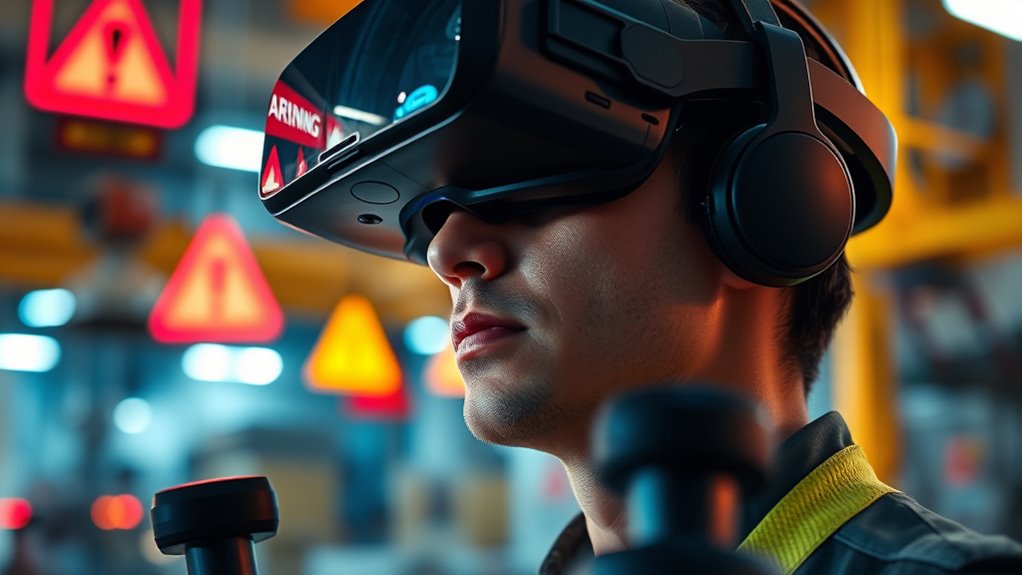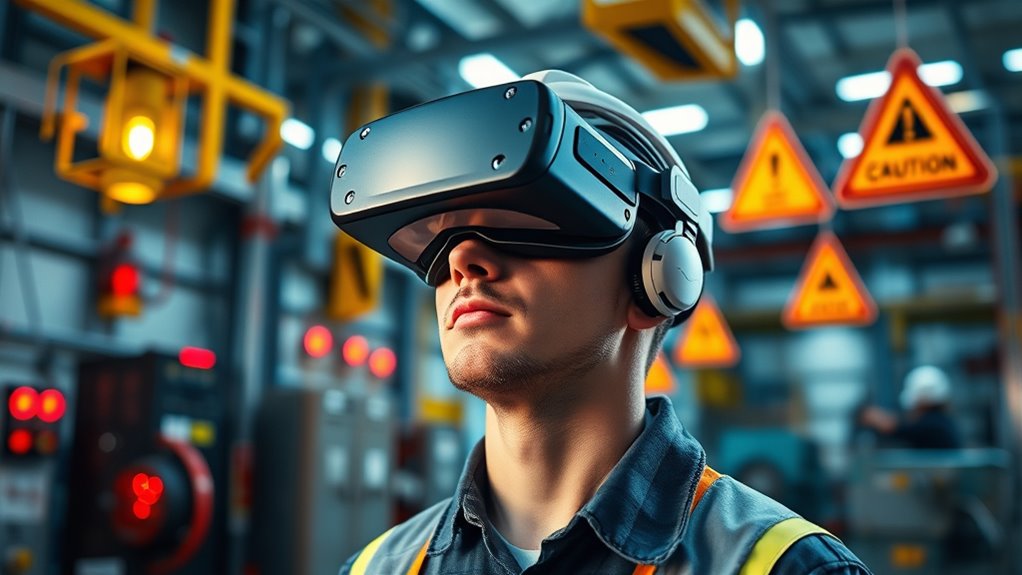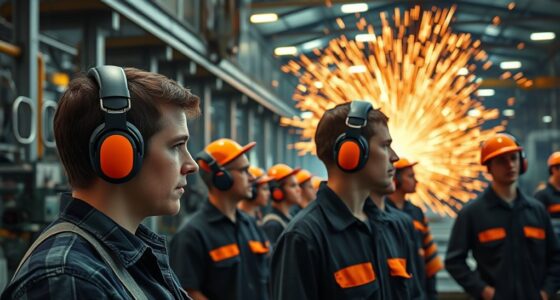VR safety training immerses you directly in realistic work environments, helping you recognize hazards more quickly and confidently. It reinforces safety protocols through hands-on practice and exposes you to dangerous scenarios in a controlled setting. Repetition guarantees you master responses and procedures, while engaging activities keep you actively involved. This immersive approach builds better preparedness and safety awareness. Keep exploring to discover how VR can transform your hazard prevention strategies even further.
Key Takeaways
- VR provides realistic, hands-on hazard recognition experiences, enhancing quick identification of workplace dangers.
- It reinforces safety protocols through immersive scenarios, improving retention and practical application.
- Repeated exposure to simulated hazards builds decision-making skills and emergency response confidence.
- VR training ensures consistency, scalability, and easy updates to safety procedures across organizations.
- Active participation in VR environments fosters engaging learning, reducing accidents and promoting safety awareness.

Have you ever wondered how virtual reality can make safety training more effective? With VR, you’re placed directly into realistic work environments, giving you a hands-on experience that traditional methods can’t match. This immersive approach markedly enhances hazard recognition, allowing you to identify potential dangers before they cause harm. Instead of passively reading about safety protocols or watching videos, you actively engage with scenarios that mimic real-life risks. As you navigate through virtual settings, you learn to spot hazards like exposed wiring, slippery floors, or malfunctioning equipment quickly and confidently. This active involvement cements your understanding of what to look for, making it easier to recognize hazards in your actual workplace.
VR safety training also helps you internalize safety protocols more effectively. When you’re immersed in a simulated environment, you’re tasked with applying safety procedures in real-time, which reinforces your knowledge and improves retention. For example, you might practice correctly shutting down machinery, wearing protective gear, or evacuating a building during an emergency. Because these scenarios are interactive, you can make mistakes without real-world consequences, giving you a safe space to learn from errors. This experiential learning approach ensures you’re not just memorizing safety rules but understanding how to implement them practically, which boosts your confidence and readiness on the job.
Immersive VR scenarios reinforce safety procedures, boosting confidence and practical understanding through hands-on, mistake-tolerant learning.
Another key benefit is that VR allows you to experience a wide range of hazardous situations within a controlled setting. This exposure prepares you for unexpected dangers that could occur in your work environment. Whether it’s dealing with chemical spills, electrical faults, or confined space entry, VR scenarios expose you to these risks repeatedly, helping you develop quick decision-making skills. The realism of VR scenarios also emphasizes the importance of following safety protocols precisely, so you see firsthand what can happen if safety procedures are neglected. This experiential learning makes safety protocols more than just rules on paper; they become critical tools you rely on during real emergencies.
Furthermore, VR safety training offers consistent, repeatable experiences. You can go through the same hazardous scenarios multiple times until you master the appropriate responses. This repetition ensures that your hazard recognition skills sharpen and your understanding of safety protocols deepens. Plus, virtual training is scalable and easily updated, meaning you can stay current with the latest safety standards without significant logistical challenges. Additionally, incorporating diverse and innovative planters and pots into training modules can enhance engagement and contextual learning. Overall, VR transforms safety training from a passive lecture into an active, engaging process that enhances hazard recognition and ensures you’re well-prepared to prevent accidents and protect yourself and others on the job.
Frequently Asked Questions
How Cost-Effective Is VR Safety Training Compared to Traditional Methods?
VR safety training is often more cost-effective than traditional methods when you consider the initial investment versus long-term savings. You’ll find that a thorough cost analysis shows reduced expenses on materials, travel, and time. Budget considerations reveal that, although setup costs are higher upfront, you save money over time by minimizing workplace accidents and training inefficiencies, making VR a smart choice for sustainable safety education.
What Industries Benefit Most From VR Safety Training Programs?
You’ll find VR safety training shining brightest in industrial sectors and construction sites—you know, those chaotic playgrounds of hazards. It’s like giving your workers a superhero suit without the awkward spandex. These industries benefit most because VR simulates dangerous scenarios safely, helping prevent real accidents. So, if you want your team to dodge disaster rather than just read about it, VR training is your new best friend.
Can VR Training Be Customized for Specific Workplace Hazards?
Yes, VR training can be customized for specific workplace hazards. You can explore personalization options to tailor modules that address unique safety challenges in your environment. By incorporating hazard-specific modules, you guarantee your team gains relevant, realistic experiences that improve hazard recognition and response. This customization makes training more effective, engaging, and directly applicable, helping your workforce stay prepared for real-world safety scenarios.
How Do Employees Generally Respond to VR Safety Training?
You’ll find that employees generally respond positively to VR safety training because it boosts engagement and makes learning more memorable. The immersive experience captures their attention, encouraging active participation. As a result, they’re more likely to retain important safety information, which helps prevent hazards in the workplace. Overall, VR training fosters a proactive safety culture, ensuring employees feel confident and prepared to handle real-world situations effectively.
What Are the Technological Requirements for Implementing VR Safety Training?
Think of implementing VR safety training as building a bridge; you need the right materials. You’ll require robust hardware setup, including VR headsets, sensors, and compatible computers. Software integration is essential to guarantee seamless operation between the training platform and your existing systems. Make certain your network supports high data transfer speeds, and consider space requirements for safe device use. With these elements in place, you’ll create an immersive, effective hazard prevention tool.
Conclusion
As you embrace VR safety training, you’ll find it like stepping into a vivid, lifelike world where hazards become clear and prevention feels natural. This immersive approach makes learning engaging and memorable, helping you respond confidently in real situations. Just as a map guides you through unfamiliar terrain, VR guides you through potential dangers, empowering you to stay safe. By adopting this innovative training, you’re not just learning—you’re experiencing safety firsthand.









